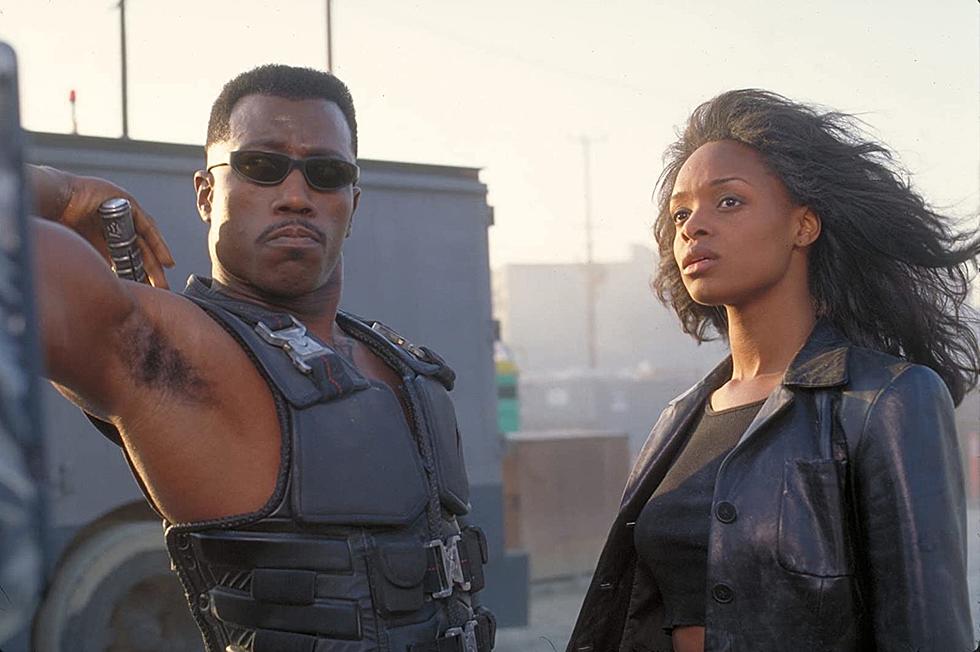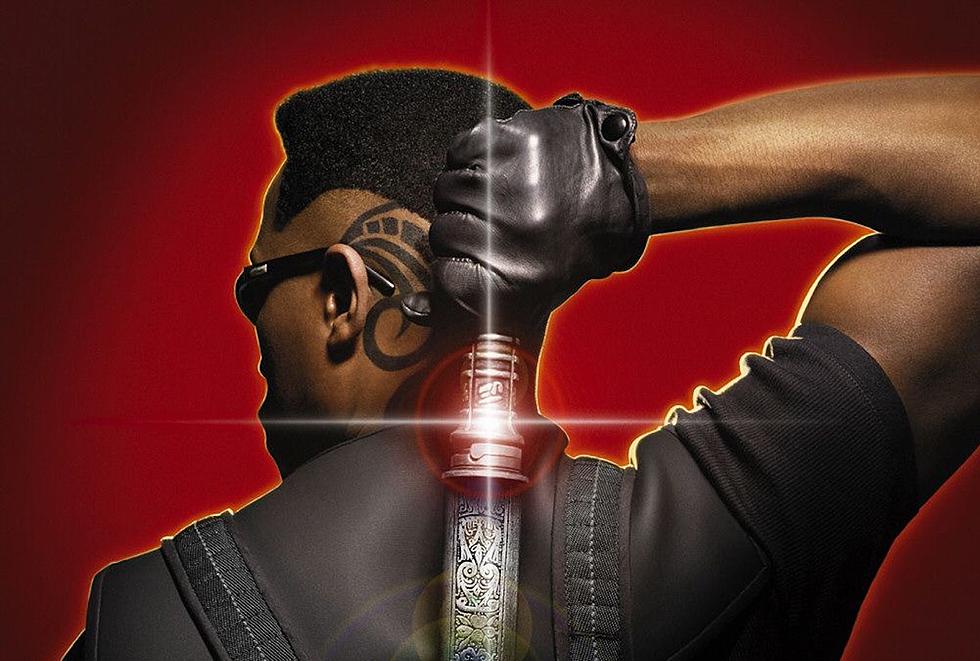
‘Blade’ Is One of the Most Influential Movies of the Last 25 Years
Wesley Snipes didn’t play Blade. He became Blade. The stories of his refusal to break character while playing Marvel Comics’ vampire hunter are legendary, particularly from the set of the series’ final film, 2004’s Blade: Trinity. According to co-star Patton Oswalt, Snipes was so deep inside Blade’s head that after the lines of communication with director David S. Goyer broke down, the star began sending him Post-It notes signed “From Blade.”
While that might have been the most extreme example of Snipes’ Method dedication, he was intensely invested in the character from the beginning. In 1998, he did at least one promotional interview for Blade as Blade. “I’m still looking for him to this day,” Snipes growls about the vampire that killed Blade’s mother, moments before he refers to “Wesley” in the third person.
A grown man talking with utter sincerity about being found as a child by Kris Kristofferson and raised as a vampire hunter is undeniably silly. Still, this clip shows just how ahead of their time Snipes and the first Blade were. In 1998, practically no one in Hollywood took comic books seriously at all, much less this seriously. From the perspective of 2020, it’s clear that Blade is one of the most important and influential movies of the last quarter century.
Before talking about Blade itself, it’s important remember the cinematic landscape in which it was created. In 1998, comic-book movies were at their lowest ebb in years. The two DC Comics adaptations the year prior to Blade’s release — Joel Schumacher’s camptacular Batman and Robin and Shaquille O’Neal’s Steel — were such critical and commercial flops that Warner Bros. wouldn’t make another DC Comics movie for seven years. For all intents and purposes, the DC Movie Universe was dead.
That was still significantly better than Marvel’s box-office track record at that time. While the company had been one of the two biggest names in comics for more than 30 years, just one of their properties had ever been adapted into a theatrically-released feature film — and it was the disastrous live-action version of Howard the Duck. The previous attempt at a Marvel movie before Blade was Roger Corman’s Fantastic Four, a production so atrocious the film has never been officially released to this day. In 2020, the Marvel Studios logo is practically a license to print money. Back then, it was box-office poison. (Or rather it would have been considered box-office poison if Marvel had their acts together enough to have their own movie logo at all; one wouldn’t arrive until 2002’s Spider-Man.)
Although Tim Burton’s Batman had become an enormous blockbuster in 1989, almost all the superhero and comic movies made in its wake were critical or commercial flops — or both. The rare success stories — 1991’s The Rocketeer, 1996’s The Phantom — were period pieces. Comic books were about as far out of the zeitgeist as you could get. They did not speak to contemporary ideas, at least as far as movies were concerned. Superheroes were relics; hokey, old-fashioned adventure stories for kids.
Not Blade. This was a comic-book movie set in a present-day world filled with vicious vampires and modern hip-hop and techno music. The very first action sequence literally showers an underground rave with blood. Blade earned its R rating — unheard of in its day, and almost as rare now, even in a landscape dominated by comic-book movies — with extensive blood and gore. Its hero even dropped the occasional F-bomb when the mood struck him:
What’s also evident in the scene above is that Blade has no concern about a “secret identity.” He strolls into a hospital, shoots at vampires, tells off cops, and leaves with an important witness with no attempt to hide his face. This was another major break with superhero movies to that point, which were entirely consumed with Supermans and Batmans and assorted other costumed do-gooders who expended enormous energy (and screen time) disguising their true identities.
Although this might not seem like a huge change, most Marvel movies followed Blade’s lead. The X-Men ditched the masks that had been a key part of many of the characters’ costumes for decades. Sam Raimi’s Spider-Man trilogy maintained Peter Parker’s secret, but then first Iron Man ended with Robert Downey Jr.’s Tony Stark declaring to the world that he was his armored alter ego. From that point on, the Marvel Cinematic Universe rarely considered secret identities again.
Blade’s armor — which debuted about six months before The Matrix made leather and black overcoats the de facto costume for an entire generation of action heroes — also broke from the tradition established by the Burton Batman movies of encasing superheroes in mountains of stiff latex. Wesley Snipes’ Blade costume is elaborate but it doesn’t restrict his movement, allowing director Stephen Norrington to deliver complex action sequences highlighting his star’s martial-arts skills.
Let’s take a look at the difference in action between Burton’s Batman and Norrington’s Blade. During Batman’s big action finale, Michael Keaton mostly stands in place while bad guys jump and kick around him. In the most extreme example, one of the Joker’s goons performs an absurd gymnastics routine, flipping down an entire hallway, then leaps at Batman with a kick. Keaton watches all of this transpire without moving a muscle, then drops the guy with one punch and some kind of Bat-gadget he extends from his hand. Fight over. It might be more accurate to call this an inaction scene.
Compare that with part of the finale from Blade, where Snipes takes on a whole army of vampires working for the evil Deacon Frost (Stephen Dorff):
Keaton’s Bat-costume gave him the illusion of an outlandish comic book physique in exchange for all of his mobility. Snipes, in contrast, needed no help in the muscle department. When he’s stripped down to the waist late in the film, he is absolutely jacked. Huge muscles were standard operating procedure in action movies during the years dominated by Schwarzenegger, Stallone, and Van Damme. After Batman, they were far less common in comic-book movies – until Blade.
The very first shot of that fight scene shows Snipes landing in a three-point stance, a modern cliche of Marvel movies that was a total rarity in live-action when Snipes did it. In general, Snipes’ movement as Blade was way ahead of his time. Without a bulky rubber costume, he was able to strike with equal amounts of grace and violence, like a cross between Bruce Lee and Mikhail Baryshnikov. Superheroes of that era could sometimes look impressive at rest; think Val Kilmer ominous looming over the Batcave in his jet-black armor. But they rarely seemed impressive in motion. Snipes’ Blade looked faster and more agile than everyone else on screen. He really sold the idea that this guy is more than human.
Amusing as that in-character interview with “Blade” from 1998 looks, it clearly shows that all of these elements were deliberate on Snipes and Norrington’s part. “Playing a comic-book character is the best of all worlds because anything goes,” Snipes says in Blade’s signature snarl during the Blade interview. “You create a different voice, create a different look, different sound, different way of moving, talking.”
Snipes concludes that interview with a prediction. “I think we’re creating a shadow world,” he says, “where the bridge between what is reality and the unreal is very small.” Not only did Blade do exactly that, but that shadow world (and Snipes’ attitude and physicality) became the template for nearly every Marvel movie that followed. Wesley Snipes had a goofy way of showing it, but he saw the future. In Blade, he helped build a bridge to a new way of bringing comic books out of the shadows.
Gallery — How Every Avenger’s Costume Evolved From Movie to Movie:
More From ComicsAlliance


![Strange Company: The Marvel Mystical Fantasy Draft, Part One [Fantasy Week]](http://townsquare.media/site/622/files/2016/10/mystic-day-one-feat.jpg?w=980&q=75)

![Marvel Still Has Plans for the Vampire Hunter ‘Blade’ [NYCC 2016]](http://townsquare.media/site/442/files/2015/07/Blade.jpg?w=980&q=75)





